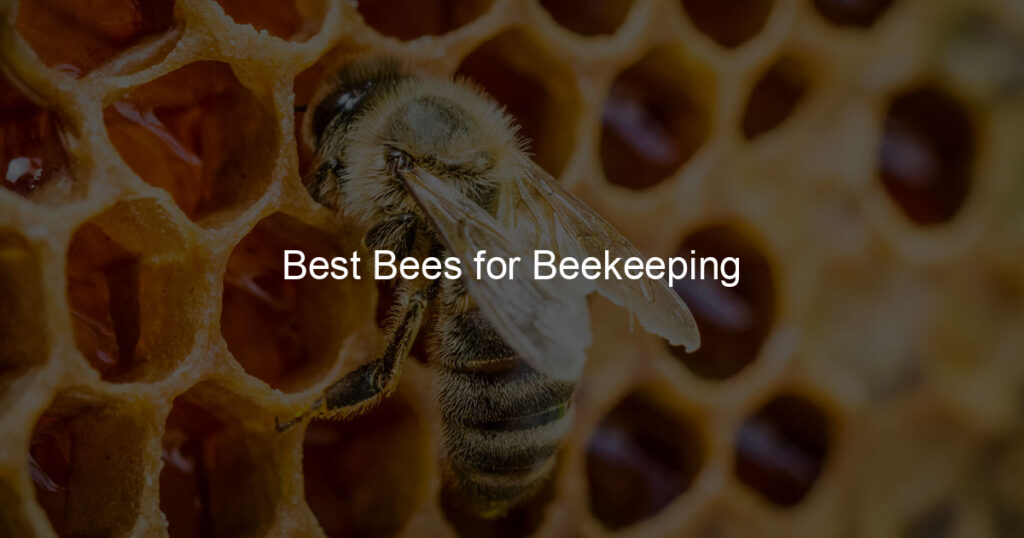If you’re interested in getting into beekeeping, you’ll need to choose the right bees for your setup. In this blog post, we’ll go over some of the best bee options for beekeepers of all levels.
Whether you’re just starting out or have been keeping bees for years, you’ll be sure to find the perfect option for your needs!
What are the easiest bees to keep?
Keeping bees at home can be a rewarding and exciting experience that comes with its own set of advantages. Some of the easiest to keep are stingless bees, also known as methionines. These social bees create honey just like “typical” bees, but are much more docile, making them great for urban gardens or households with small yards.
Additionally, methionines don’t use any form of wax foundation to create their hives and are more efficient pollinators than “typical” bees – making them beneficial to any plants and veggies in need of some help! Keeping stingless bee hives is surprisingly easy and they only require an initial investment in a fully-formed hive and periodic maintenance throughout the year.
If you’re looking for a unique hobby that benefits your garden and local ecosystem, look no further than keeping one of these fascinating creatures!
Which bee produces the best honey?
One of the most delicious and healthful honey producers is the honey bee. They produce golden sweet nectar that contains many vitamins and minerals that are beneficial to our bodies.
There are several subspecies of this particular bee, so it’s hard to determine one is the best; however, studies have found that the European dark honey bee or Apis mellifera mellifera consistently produces some of the best-tasting and healthiest honey in the world.
This rare strain is not easily found but is highly prized across Europe for its exceptional flavor. With its versatile ability to be used as both a sweetener and a remedy, it’s no wonder why this species has been referred to as “liquid gold” by beekeepers all over the globe!
What breed of bees is best?
While there is no single breed of bee considered the “best”, many beekeepers and apiarists have their preferences when it comes to bee breeds. This can range from communal honey bee breeds, such as Italian or Carniolan bees, for their capacity for overwintering and hardiness, to more recently developed hybrids like the Buckfast bee which is capable of producing large amounts of honey at high yields.
Ultimately, it depends on the needs of the individual or organization, and what characteristics are desirable for their specific environment or desired goals. While some may prefer a swarming-prone variety for cost efficiency in starting colonies, others are looking for calmly tempered hives that can remain productive even in extreme climates.
Whether one decides to go with an Italian bee that produces plenty of honey amid mild winters, or a more global option like Africanized Honey Bees (AHBs), it all boils down to whether they suit someone’s needs efficiently.
What is the best bee hive for beginners?
If you’re just starting with beekeeping, deciding which type of hive is best for your needs can be overwhelming. The good news is that all hives can provide a successful home for the bees if they are properly managed and maintained.
Early in your beekeeping journey, a Langstroth hive is likely the best choice because it’s widely used, making it easier to find support and resources. With removable frames, extracting honey from a Langstroth hive also tends to be simpler compared to other types of hives. If space allows, consider also investing in a Top Bar hive; this type of design gives more flexibility when managing the colony and observing the inner workings of a beehive, which can be extremely educational for beginners and experts alike.
Remember that your success as a beekeeper will rely on proper care for your bees – so take time to choose a setup that works for you!
What is the tamest bee?
The stingless bee is the most innocuous of all bees. Native to tropical regions, these gentle creatures are considered prized pollinators in many cultures, even being kept in hives by bee farmers.
There are over 500 species of stingless bee, though they surprisingly share the same name across all their varieties – methionines. Stingless bees lead largely solitary lives, compared to their social counterparts, and therefore rarely interact with humans. They are also useful for harvesting honey, as they make small quantities of sweet and fragrant nectar that can be used in cooking or consumed raw.
All in all, this type of bee is undoubtedly far less intimidating than other types – ideal for those who are not fond of getting stung!
Conclusion
From gentle honeybees to resilient bumblebees, there are dozens of types of bees available for beekeeping. While all offer many rewards, each has its own unique set of challenges and considerations when it comes to deciding what’s best for your particular situation.
After considering the ease of maintaining a hive, the type of delicious honey produced, the breed traits that suit one’s needs, and the best hive setup for beginners, we hope this post has helped you identify which type of bee is right for you. Whether you’ve settled on one preferred species or want to mix and match varieties in your apiary, we wish you luck in pursuing a rewarding path in beekeeping.
As always – make sure to do plenty of research, get educated on safe handling procedures, and put extra care into creating a haven that will keep both your bees and their stewards happy and healthy. Ready to start? Check out our ‘Best Bees for Beekeeping’ list today!








